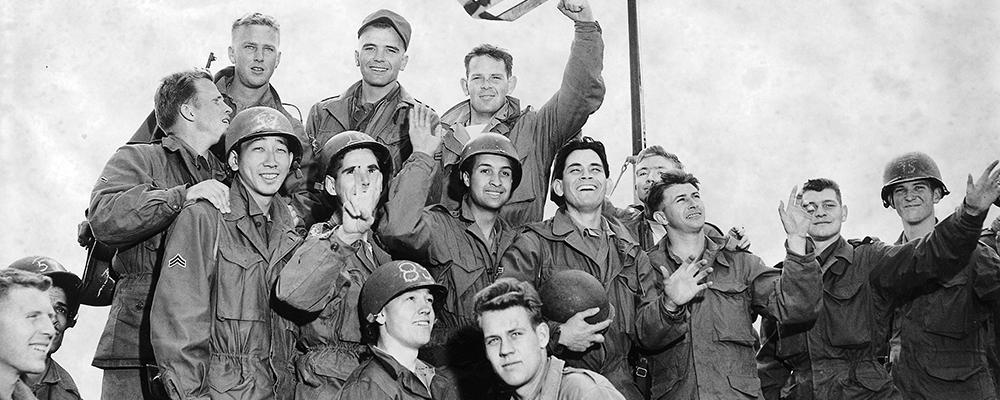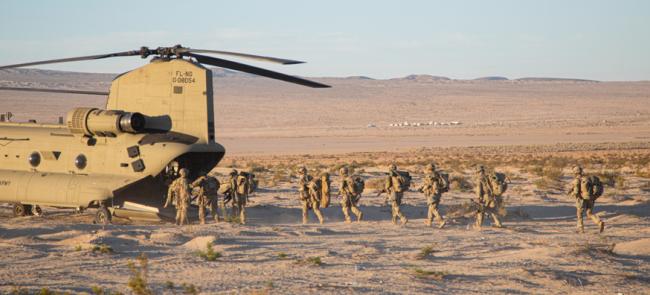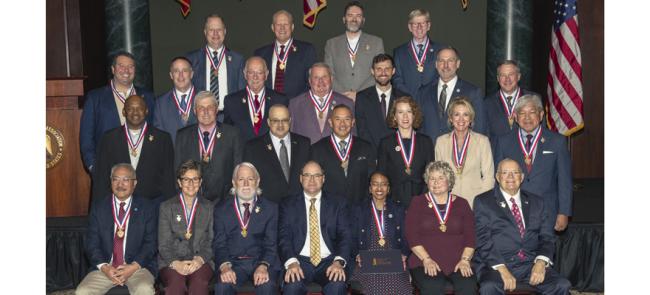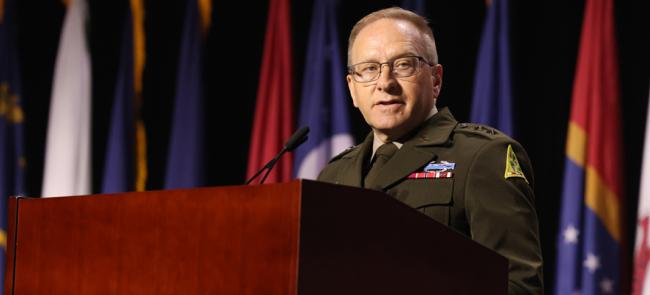
Worth Remembering
Often forgotten in history, the Korean War left some indelible marks on the Guard
Wyoming Army National Guard soldier William W. Day IV’s first day of combat was a feverish race to ward off a Chinese onslaught.
“The guns are hot and the ammo can’t be uncrated fast enough,” he wrote in The Running Wound: APersonal Memory of the Korean War. “The motor pool is using every truck to haul the ammo. The cooks, clerks and everyone else available are preparing ammo while the gun crews stay at their post and continue to pour another withering fire on the enemy.
“The Chinese are now within 700-800 yards and as our shells land among them, arms, rifles and equipment fly in every direction,” added the member of the 300th Armored Field Artillery Battalion.“It’s a human wave.”
Day’s description is similar to what many Guard soldiers experienced by the time they reached the war zone. In most cases, they were quickly rushed to the front to help stop the Communist Chinese onslaught.
China’s entry in the conflict was another in a series of stunning developments in the war’s formative months. The first was communist North Korea’s surprise invasion of democratic South Korea on June 25, 1950. North Korean troops quickly took Seoul, South Korea’s capital, and nearly drove the undermanned U.S. and South Korean forces off of the peninsula.
President Harry S. Truman dispatched U.S. forces from Japan and began mobilizing Guard units. He also sought and received help from the United Nations Security Council, which for the first time asked member nations to provide troops.
Things were still perilous Sept. 15 when Gen. Douglas MacArthur, then the head of the U.N.Command in Korea, sent U.S. and U.N. forces ashore at Inchon, midway up the Korean peninsula near Seoul. The move surprised and flanked the North Koreans, cutting their supply lines and forcing them to withdraw in disarray. U.S. and U.N. force then methodically drove the enemy not only out of South Korea, but also within a few miles of North Korea’s border with China.
The conflict appeared to be coming to a quick conclusion and the Guard would not be needed. In November 1950, NGAUS held the position that the fighting was essentially the responsibility of active forces that “might necessitate” the use of “certain elements” of the Guard and other reserve components.
Retired Maj. Gen. Ellard A. Walsh, the association president, argued that a full mobilization might hurt the economy. He also feared that too many Guard units would be mobilized only to sit in their armories for extended periods.
Then, much to the surprise of the U.S. intelligence, thousands of seemingly fearless Chinese troops entered the fray in late 1950. Any notion of a quick end to hostilities vanished.
The Korean War was a different kind of conflict than the nation and the Guard had grown accustomed. Unlike World War I and II, there would be no full mobilization. There would also be no clear-cut, absolute objectives, other than preventing an escalation of the fighting that could trigger another global war and a possible nuclear confrontation between the United States and Soviet Union. Truman went so far as to call the conflict a “police action.”
Consequently, there was only a partial mobilization of reservists. Those called would serve only 21months, which was later increased to 24 months.
Still, thousands of Guard soldiers had reported for active duty by the fall of 1950. Many came from four infantry divisions: the 28th (Pennsylvania), the 40th (California) the 43rd (Connecticut, Rhode Island and Vermont) and the 45th (Oklahoma). The 40th and 45th eventually went to Korea; the28th and 43rd deployed to Europe to bolster NATO. Hundreds of separate combat, combat support and combat service support units also mobilized.
Within a year, nearly 110,000 Army Guard soldiers were on active duty, or about one-third of the force. Thousands more mobilized later in the war. About 45,000 Air Guardsmen —a figure that constituted the organization’s entire 1950 end strength — mobilized for the conflict (sidebar, Dumbo Factor).
Both Guard organizations began training for possible deployment without some of their key equipment, which had been recalled by active units immediately heading to the fight. Among the army Guard items taken were 592 tanks and 5,600 trucks and other vehicles. The Air Guard was suddenly without 145 F-51 Mustang fighters. The older propeller-driven aircraft were needed because they could operate on the smaller, less developed airfields initially available.
As the first Army Guard units arrived in Korea, U.S. and U.N. forces were reeling back over the old border between the two Koreas under the weight of the massive Chinese offensive. Communist forces captured Seoul again. The U.N. lines stabilized just south of the city, despite numerous Chinese attacks.
In January 1951, seven Army Guard units, all truck outfits, arrived in Korea. As soon as their arrived in Pusan at the southern tip of the Korean peninsula, truckers were dispatched to carry supplies and personnel up to the front, often coming under direct attacks. They later carried the wounded to field hospitals.
Guard combat support units arrived soon after, a welcome reinforcement to the hard-pressed U.N.armies. They included nine artillery battalions with 105mm and 155mm howitzers. All nine were heavily engaged in the fighting in March when the Chinese began a new offensive.
The first Air Guard units in the fight were two fighter-bomber wings equipped with F-84EThunderjets, which were used primarily to protect B-26 and B-29 bombers against attack by enemy aircraft. They were also able to conduct their own bombing and strafing in a ground support role.
The wings included squadrons from Arkansas, California, Florida, Georgia and Texas. They operated out of bases in Japan.
By the time the 40th and 45th divisions got in the fight in 1952, the war had settled into a bloody stalemate as U.N. and communist forces occupied trench lines on opposing ridges stretching across the peninsula.
The front was roughly along the 38th Parallel, the pre-war border between the two Koreas. Although peace talks had opened in late 1951, there was little prospect of an end to the fighting.
Combat at this point usually meant patrols, trench raids and localized attacks to capture prisoners or small areas of territory. However, at times the fighting raged into serious battles as larger assaults, such as the Chinese spring offensive, brought thousands of men into action.
In areas not directly involved in the fighting, a cautious calm kept the troops on edge. But for many soldiers serving in Korea, the biggest enemy during the winter of 1951-1952 was the brutal cold. Men huddled in their trenches and bunkers just trying to keep warm.
The two Guard divisions replaced two active-component formations — the 40th relieved the 24thInfantry Division while the 45th took over for the 1st Cavalry Division.
But what these incoming Guardsmen found was disheartening. Both divisions had to leave their vehicles and heavy weapons behind at their training bases in Japan. The equipment they inherited was old and worn out. Fortunately, they did have some “quiet” time for repairs before the first major engagements in the spring.
Soon both divisions became deeply involved in combat, participating in battles large and small. Locations not found on many prewar map began appearing in hometown newspapers. They included the now infamous T-Bone Hill, Ice Cream Cone Hill, Heartbreak Ridge and the Punchbowl.
In one of the many odd twists to the war, many Guardsmen assigned to the two Guard divisions were eligible to go home not long after arriving in Korea. This was due to the limits of their call-up. At issue was the amount of time a Guardsman could be kept on active duty without Congressdeclaring a national emergency (which it never did during the Korean War). In fall 1950, when the 40th and 45th divisions were mobilized, that limit was 21 months.
Further reducing their time was an Army “points” system for rotation home. It took into account a number of factors such as service overseas in the theater of operations, including Japan. Since both divisions trained there for more than six months before deploying to Korea, this reduced each man's time by two months.
The Army decided to rotate home those Guardsmen who didn’t volunteer to stay (and a number did) and fill their positions with newly trained draftees. By mid-1952, many Army Guard units in Korea had few Guardsmen in their ranks, but the two division flags did not come home until well into 1954.
In contrast to the Army, the Air Force rotated whole Air Guard units back home. This could be done because, unlike Army Guard outfits that contained large numbers of draftees, most Air Guard units were still comprised primarily of Air Guardsmen.
The war's last major ground engagement involved both Guard divisions and at least 12nondivisional Guard units. During the Battle of the Kumsong River Salient, July 13 to 20, 1953, the Chinese launched a massive, six-division assault against the U.N. forces.
After seven days of fierce fighting, the communists were pushed back to their own defensive positions, and most combat ceased. One week later, on July 27, 1953, representatives of the United States, the U.N., South Korea, Communist China and North Korea signed an armistice ending 37 months of bloody warfare.
More than 29,500 Americans were killed in combat with 7,425 others listed as missing in action. How many of these men were Guardsmen cannot be determined from existing records. No doubt thousands of Guardsmen gave their lives in the first shooting war of the Cold War.
The war and its aftermath brought several changes to the Guard. One was Army Guard training. Prior to 1950, Guardsmen received their basic and, in most cases, their advanced individual training, from unit senior noncommissioned officers. Training standards varied. Consequently, many guardsmen weren’t fully prepared to perform assigned tasks upon mobilization.
Guard leaders had previously asked the Army to offer AIT to most Guardsmen, but the Army refused, citing limited budgets. After Korea, Army officials assessed Guard pre-war preparation and decided that all Guardsmen would receive basic training and AIT at Army schools.
Training was further enhanced with the advent of the weekend drill. Although not official policy until the early 1970s, switching from evening drill periods, a staple of militia units since the 18thcentury, provided more hands-on time with complicated arms and equipment than four hours once a week would permit.
And these weekend drills were starting to be performed in new armories and training centers. Before the Korean War, the Guard relied on inadequate state-provided facilities. After the war, Congress appropriated millions of dollars to construct modern armories and upgrade Guard camps. The Air Guard also received funds to construct aircraft storage and maintenance facilities.
There was also greater Black participation after the war. Truman’s 1948 executive order to integrate the U.S. military failed to prevent some states from maintaining segregated units. Once federally mobilized, however, all Guard outfits, regardless of their racial composition in a state status, included men from all races.
Some states tried to re-segregate Guard units integrated during the war, even barring from some outfits Black combat veterans who tried to join. The obstacles to Black participation drew protests. In some cases, the pressure reduced barriers. The question of race, however, would plague theArmy Guard until the mid-1960s when Pentagon threats to cut funding forced states to fully integrate their units.
Korean War veterans also forced the doors open to female participation in the Guard, which had no women in 1953. Records indicate that a number of highly qualified nurses and other female veterans sought to join their local Guard units only to be refused admittance. There simply was no authority to enable them to join.
It was only under pressure from the National Guard Bureau and women veterans that Congress enacted a law in 1956 allowing female officers in the Guard. The first to join was Capt. NormaParsons, a Korean War veteran who brought a wealth of experience to the New York Air Guard.
Often forgotten in history, the Korean War was the Guard’s most significant event of the latter half of the 20th century. Nearly 200,000 Guardsmen were mobilized, serving at home and Europe as well as on the Korean peninsula.
Perhaps even more important, the war triggered significant changes to Guard training, resources and demographics. The post-Korean War Guard bears little resemblance to its predecessor.



